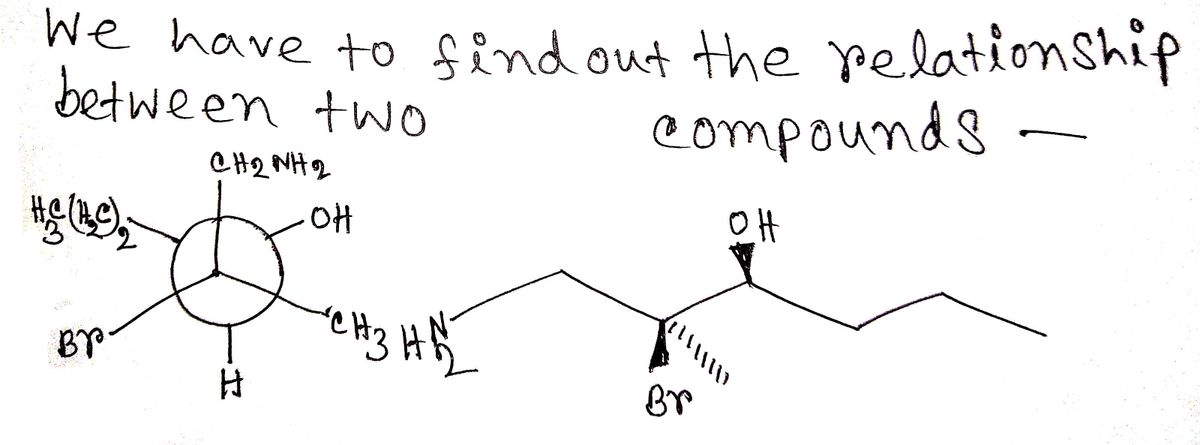Chemistry
10th Edition
ISBN:9781305957404
Author:Steven S. Zumdahl, Susan A. Zumdahl, Donald J. DeCoste
Publisher:Steven S. Zumdahl, Susan A. Zumdahl, Donald J. DeCoste
Chapter1: Chemical Foundations
Section: Chapter Questions
Problem 1RQ: Define and explain the differences between the following terms. a. law and theory b. theory and...
Related questions
Question
Are the compounds presented conformational isomers, meso compounds, enantiomers, diastereomers, or constitutional isomers? Explain.

Transcribed Image Text:The image displays two chemical structures.
1. **Left Structure**: This is a Newman projection. Newman projections show molecules from a perspective looking straight down the bond between two carbon atoms.
- The central circle represents the front carbon atom.
- The bonds radiating from this circle are the substituents attached to the front carbon: \( \text{CH}_2\text{NH}_2 \), \( \text{OH} \), and \( \text{CH}_3 \).
- The lines extending from the bonds (but not connected to the circle) indicate substituents on the back carbon atom: \( \text{Br} \), \( \text{H} \), and a longer carbon chain \( \text{H}_3\text{C(CH}_2)_2 \).
2. **Right Structure**: This is a three-dimensional representation of a molecule.
- The molecule has four carbon atoms in a chain, with additional substituents.
- The substituents include an \( \text{NH}_2 \) group, a \( \text{Br} \) atom, and an \( \text{OH} \) group.
- Wedge and dash bonds are used to represent the three-dimensional orientation of the substituents. The wedge (solid triangle) represents a bond coming out of the plane towards the viewer, while the dashed line represents a bond going behind the plane.
These illustrations are used to depict stereochemistry, the spatial arrangement of atoms, in organic molecules.
Expert Solution
Step 1

Step by step
Solved in 5 steps with 5 images

Knowledge Booster
Learn more about
Need a deep-dive on the concept behind this application? Look no further. Learn more about this topic, chemistry and related others by exploring similar questions and additional content below.Recommended textbooks for you

Chemistry
Chemistry
ISBN:
9781305957404
Author:
Steven S. Zumdahl, Susan A. Zumdahl, Donald J. DeCoste
Publisher:
Cengage Learning

Chemistry
Chemistry
ISBN:
9781259911156
Author:
Raymond Chang Dr., Jason Overby Professor
Publisher:
McGraw-Hill Education

Principles of Instrumental Analysis
Chemistry
ISBN:
9781305577213
Author:
Douglas A. Skoog, F. James Holler, Stanley R. Crouch
Publisher:
Cengage Learning

Chemistry
Chemistry
ISBN:
9781305957404
Author:
Steven S. Zumdahl, Susan A. Zumdahl, Donald J. DeCoste
Publisher:
Cengage Learning

Chemistry
Chemistry
ISBN:
9781259911156
Author:
Raymond Chang Dr., Jason Overby Professor
Publisher:
McGraw-Hill Education

Principles of Instrumental Analysis
Chemistry
ISBN:
9781305577213
Author:
Douglas A. Skoog, F. James Holler, Stanley R. Crouch
Publisher:
Cengage Learning

Organic Chemistry
Chemistry
ISBN:
9780078021558
Author:
Janice Gorzynski Smith Dr.
Publisher:
McGraw-Hill Education

Chemistry: Principles and Reactions
Chemistry
ISBN:
9781305079373
Author:
William L. Masterton, Cecile N. Hurley
Publisher:
Cengage Learning

Elementary Principles of Chemical Processes, Bind…
Chemistry
ISBN:
9781118431221
Author:
Richard M. Felder, Ronald W. Rousseau, Lisa G. Bullard
Publisher:
WILEY